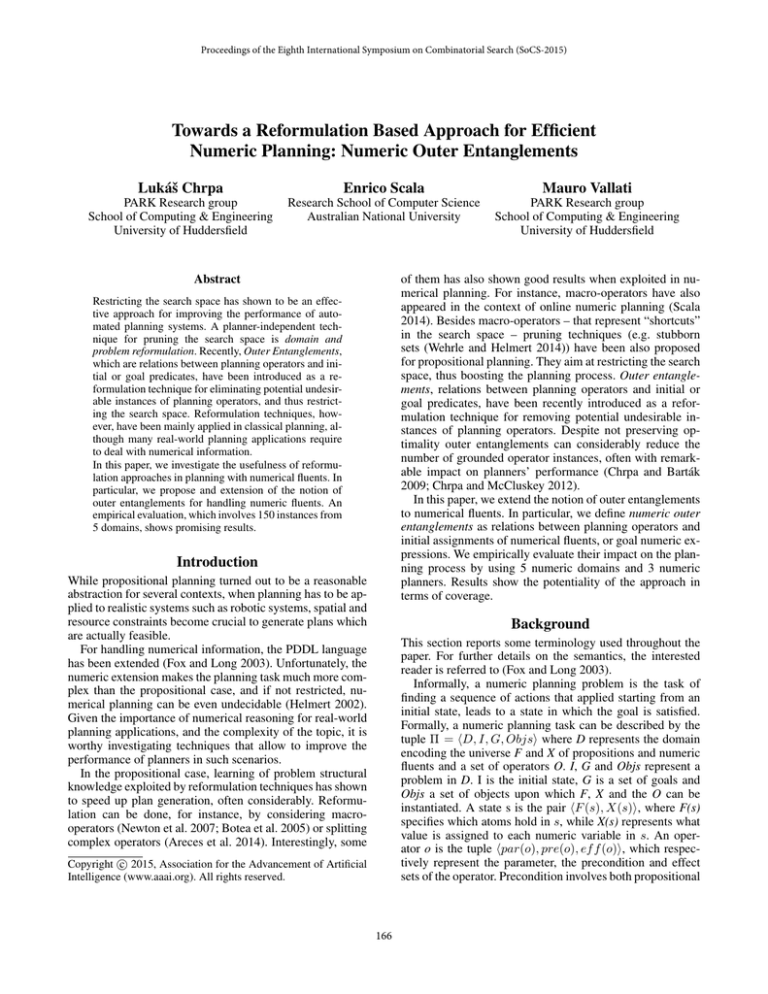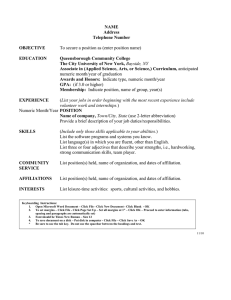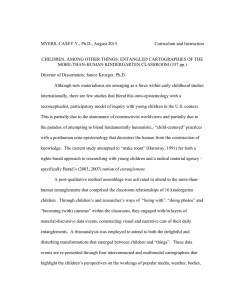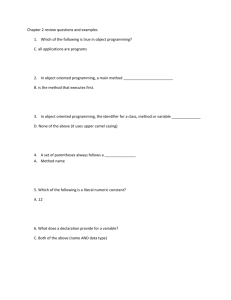
Proceedings of the Eighth International Symposium on Combinatorial Search (SoCS-2015)
Towards a Reformulation Based Approach for Efficient
Numeric Planning: Numeric Outer Entanglements
Lukáš Chrpa
Enrico Scala
Mauro Vallati
PARK Research group
School of Computing & Engineering
University of Huddersfield
Research School of Computer Science
Australian National University
PARK Research group
School of Computing & Engineering
University of Huddersfield
Abstract
of them has also shown good results when exploited in numerical planning. For instance, macro-operators have also
appeared in the context of online numeric planning (Scala
2014). Besides macro-operators – that represent “shortcuts”
in the search space – pruning techniques (e.g. stubborn
sets (Wehrle and Helmert 2014)) have been also proposed
for propositional planning. They aim at restricting the search
space, thus boosting the planning process. Outer entanglements, relations between planning operators and initial or
goal predicates, have been recently introduced as a reformulation technique for removing potential undesirable instances of planning operators. Despite not preserving optimality outer entanglements can considerably reduce the
number of grounded operator instances, often with remarkable impact on planners’ performance (Chrpa and Barták
2009; Chrpa and McCluskey 2012).
In this paper, we extend the notion of outer entanglements
to numerical fluents. In particular, we define numeric outer
entanglements as relations between planning operators and
initial assignments of numerical fluents, or goal numeric expressions. We empirically evaluate their impact on the planning process by using 5 numeric domains and 3 numeric
planners. Results show the potentiality of the approach in
terms of coverage.
Restricting the search space has shown to be an effective approach for improving the performance of automated planning systems. A planner-independent technique for pruning the search space is domain and
problem reformulation. Recently, Outer Entanglements,
which are relations between planning operators and initial or goal predicates, have been introduced as a reformulation technique for eliminating potential undesirable instances of planning operators, and thus restricting the search space. Reformulation techniques, however, have been mainly applied in classical planning, although many real-world planning applications require
to deal with numerical information.
In this paper, we investigate the usefulness of reformulation approaches in planning with numerical fluents. In
particular, we propose and extension of the notion of
outer entanglements for handling numeric fluents. An
empirical evaluation, which involves 150 instances from
5 domains, shows promising results.
Introduction
While propositional planning turned out to be a reasonable
abstraction for several contexts, when planning has to be applied to realistic systems such as robotic systems, spatial and
resource constraints become crucial to generate plans which
are actually feasible.
For handling numerical information, the PDDL language
has been extended (Fox and Long 2003). Unfortunately, the
numeric extension makes the planning task much more complex than the propositional case, and if not restricted, numerical planning can be even undecidable (Helmert 2002).
Given the importance of numerical reasoning for real-world
planning applications, and the complexity of the topic, it is
worthy investigating techniques that allow to improve the
performance of planners in such scenarios.
In the propositional case, learning of problem structural
knowledge exploited by reformulation techniques has shown
to speed up plan generation, often considerably. Reformulation can be done, for instance, by considering macrooperators (Newton et al. 2007; Botea et al. 2005) or splitting
complex operators (Areces et al. 2014). Interestingly, some
Background
This section reports some terminology used throughout the
paper. For further details on the semantics, the interested
reader is referred to (Fox and Long 2003).
Informally, a numeric planning problem is the task of
finding a sequence of actions that applied starting from an
initial state, leads to a state in which the goal is satisfied.
Formally, a numeric planning task can be described by the
tuple Π = hD, I, G, Objsi where D represents the domain
encoding the universe F and X of propositions and numeric
fluents and a set of operators O. I, G and Objs represent a
problem in D. I is the initial state, G is a set of goals and
Objs a set of objects upon which F, X and the O can be
instantiated. A state s is the pair hF (s), X(s)i, where F(s)
specifies which atoms hold in s, while X(s) represents what
value is assigned to each numeric variable in s. An operator o is the tuple hpar(o), pre(o), ef f (o)i, which respectively represent the parameter, the precondition and effect
sets of the operator. Precondition involves both propositional
c 2015, Association for the Advancement of Artificial
Copyright Intelligence (www.aaai.org). All rights reserved.
166
meric conditions are often used to represent consumable and
continuous resources (e.g., the fuel required to perform a fly
action). In this context, numeric entanglements can be used
to understand if there exists a relation between an operator
and the initial resource at disposal.
Therefore, analogously to the propositional case, a numeric entanglement is defined as follows:
Definition 2 (Numeric Outer Entanglement by Init)
Given a Planning Task Π = hD, I, G, Objsi, we say that
an operator o is numerically entangled by I with c if
∃π ∈ sol(Π) such that ∀a ∈ π where a ∈ grounding(o)
then cgnd ∈ pre(a) ⇒ I |= cgnd , that is the evaluation of
the condition c in I is satisfied in an arithmetical way.
It is worth noting that this definition only deals with the
by-init case. Extending the notion of outer entanglements for
considering relation between operators and numeric condition in the goal is not straightforward. The problem relies on
the fact that a numeric condition does not inherit the same
state based interpretation of the propositional case. In the
classical case in fact it is possible to reason on action effects and goal statements homogeneously since both represent partial world states. The propositional outer entanglement condition by goal is hence quite symmetrical to the
one defined for the by-init case. On the contrary, action numeric effects are functions of the state in which the action is
applied. The resulting execution is not independent from the
particular context.
However, it is possible to find a restricted definition of
numeric entanglements by goal. The idea is to consider only
those relations between numeric effects and numeric goals in
which it is possible to show that the execution of the action
always satisfies the numeric condition. Formally:
Definition 3 (Numeric Outer Entanglement by Goal)
Given a planning task Π = hD, I, G, Objsi, we say
that an operator is numerically entangled by G with c if
∃π ∈ sol(Π) such that ∀ a ∈ π where a ∈ grounding(o) it
gnd
gnd
] |= cgnd
∈ ef fnum (a) ⇒ s∗ [ef fnum
holds that ef fnum
∗
P
|X|
where s ∈ 2 × R and cgnd ∈ G.
State s∗ represents any possible state within the space of
ground
] is
states generated by the planning problem, s∗ [ef fnum
the state resulting from the application of a numeric effect
of a on s∗ . Numeric effects and numeric conditions can be
quite complex as they may involve complicated expression.
A sufficient condition for finding this kind of relation is to
restrict the attention to simple forms of numeric conditions
and operators. In particular, numeric conditions containing
only one numeric fluent (e.g., ( > (power r1) 5)) assign effects which assign a value to the numeric fluent object
of the condition (e.g, (= (power r1 10) ))1 .
statements and numeric conditions in form of inequalities
({<,<=,==,>=,>} exp exp’). Effects of the operator include classical add and delete list (add(o), del(o)), but
also a set of numeric effects of the form (op x exp)
where x is the fluent affected by the operation and op ∈
increase, decrease, assign. exp and exp’ are arithmetical
expressions over variables from X. An instance of operator
o is obtained grounding its parameters with a set of objects
which have to be consistent with the types defined in par(o).
A solution plan π for Π is a sequence of actions whose
execution leads the state I to a state s|π| satisfying G and
sol(Π) is a set of all solution plans of Π. Moreover, a solution plan is such that I |= pre(a0 ), I[a0 ] |= pre(a1 ) ...
I[a0 , a1 , ...an−2 ] |= pre(an−1 ) where the operation s[a] defines the state resulting from the application of a in s.
Propositional Outer Entanglements
Outer Entanglements are relations between planning operators and initial or goal predicates, and have been introduced as a technique for eliminating potential unnecessary
instances of these operators (Chrpa and McCluskey 2012).
Informally, entanglements by init capture situations where
only instances of a given operator that require the same instances of a certain predicate as initial ones are needed to
solve the problem. Similarly, entanglements by goal capture situations where only instances of a given operator that
achieve the same instances of a certain predicate as goal ones
are needed to solve the problem.
For example, in the BlocksWorld domain, the operator
unstack is entangled by init with the predicate on, since unstacking blocks only from their initial positions is sufficient.
Similarly, the operator stack is entangled by goal with the
predicate on, since stacking blocks only to their goal positions is sufficient.
Definition 1 (Propositional Outer Entanglement) Given
a Planning Task Π = hD, I, G, Objsi, we say that operator
o is entangled by I (resp. G) with predicate p in Π if and
only if p ∈ pre(o) (resp. p ∈ add(o)) and ∃π ∈ sol(Π) such
that ∀a ∈ π where a ∈ grounding(o), and ∀pgnd , where
pgnd ∈ grounding(p), it holds: pgnd ∈ pre(a) ⇒ pgnd ∈ I
(resp. pgnd ∈ add(a) ⇒ pgnd ∈ G).
Outer entanglements have been used as a reformulation
technique, as they can be directly encoded into a problem
and domain model. The way outer entanglements are encoded is inspired by one of their properties: given a static
predicate ps , an operator o is entangled by init with ps if and
only if ps ∈ pre(o) (Chrpa and Barták 2009). Introducing
supplementary static predicates, “clones” of the predicates
involved in the outer entanglement, and putting them into
preconditions of operators in the outer entanglement relation
(both init and goal) will filter instances of these operators
which do not follow the entanglement conditions. For a formal description of the reformulation process, the interested
reader is referred to (Chrpa and McCluskey 2012).
Reformulation
Definition 2 states that, if there exists an operator entangled
by init with some condition c, then there exists a solution for
the problem that does not include any instance of that operator whose entangled precondition is not satisfied. In order
Numeric Entanglements
1
Focusing on a simplified form of numeric effects turns out to
be fruitful also in other contexts, such as (Coles et al. 2013)
For the numeric case the idea is to relate the applicability
of an action to a particular configuration of states in X. Nu-
167
straint by using the initial values for the numeric fluents. If
the inequality is satisfied then the counter is increased.
The approach extends the learning approach pursued by
(Chrpa and McCluskey 2012) where a flaw-ratio is used to
allow a small percentage of “errors” in the training plans,
since they might, for instance, contain useless instances of
an operator that might cause a given condition to be not considered as an entanglement condition. If a flaw-ratio is used,
detected entanglements have to be cross-validated, so the
training problems are reformulated and passed to the planner. If the planner fails in any of the reformulated problems,
the flaw-ratio is reduced and the learning procedure is repeated.
In the algorithm the function abs abstracts a given action
instance to the corresponding operator. The procedure focuses on entanglements by init. The extension to entanglements by goal is straightforward.
to prune those instances, for each entangled condition we
reformulate the problem by inserting a new set of numeric
fluents having the same parameters of the fluents involved in
the entangled condition. As for the propositional case, these
fluents have to encode the initial state of the system and have
to be static (no actions can modify their value). Then, we
can exploit these fluents for building a new set of static preconditions. As a matter of fact, it holds that if an action is
numerically conditioned by a comparison c in which all the
involved fluents are static, then the action is numerically entangled with the initial status with c.
For instance, if one has the entangled condition
(> (fuel r1) 5), it is necessary to encode the new
fluent (fuel1 r1), set the initial value such that
fuel1=fuel, and add a new condition in the operator,
having fuel1 as parameter (> (fuel1 r1) 5). Then
the only possible groundings for this operator will be the
ones satisfying the numeric entanglement condition by init.
Reformulating problems for numeric entanglements by
goal is achieved in a similar way. In particular our
reformulation focuses on entanglements by goal where
the numeric condition in the goal is of the form
({<,<=,==,>=,>} f k) where f is an element from
X, k is a constant real number and the operator’s effect is
(= f 0 z 0 ). Here f’ is the abstracted version of f and z’ is
another real number. To preserve only operator’s entangled
with the condition, we add a new precondition to the action
which is satisfied only when the grounding of f’ corresponds
to f. This reformulation assumes that there are no other comparisons in the goal involving the same numeric fluent. Generalising the reformulation for a larger set of entanglements
is object of our future work.
Algorithm 2: Learning Propositional and Numeric Entanglements by Init
Input: D: Domain
Ps: Problems set
Plans: Plans set
f: flaw-ratio
Output: prop ent(D) ∪ num ent(D)
1 **set #sat and #occ to 0 for each operator’s condition**
2 forall the P ∈ P s do
3
plan = pick solution(hD, P si, P lans);
4
forall the action a ∈ plan do
5
forall the c ∈ P re(a) do
6
if c ∈ F (D) then
7
if c ∈ init(P ) then
8
#sat(c,abs(a)) += 1
Learning Entanglements
Discovering valid propositional entanglements has been
shown to be infeasible from a practical point of view since
the problem of deciding if an operator is entangled for a
given propositional condition is as hard as the planning
problem itself (Chrpa, McCluskey, and Osborne 2012). Although formal results do not exist for the numeric case, the
arising decision problem for numeric entanglements is likely
to be at least as hard as for the propositional case.
To alleviate this problem this paper proposes an approximate approach; i.e., given a set of easy instances for a given
domain, and a set of plans representing valid solutions for
those instances, we generalise the entanglement detected
as valid entanglement for that domain. Although such an
approach is generally incomplete, lessons learnt from the
propositional case indicate that making a problem unsolvable rarely occurs (Chrpa and Barták 2009). Algorithm 2
details the learning strategy implemented.
The procedure iterates over a set of plans, and for each of
them keeps track of the number of times a given condition
is the entanglement (initial) condition for a corresponding
given problem. Both propositional and numeric entanglements can be detected whenever an instance of an operator
is inspected. For the propositional case it suffices to see if
the initial state “contains” the current proposition. For the
numeric case it is necessary to evaluate the numeric con-
11
else if c is a num condition then
if init(P ) |= c then
#sat(c,abs(a)) += 1
12
#occ(c,abs(a)) += 1;
9
10
13
14
ents={(c, o) : ∃o ∈ O(D), c ∈ pre(o),
return ents
#sat(c,o)
#occ(c,o)
≥ (1 − f )}
Experimental Analysis
In this section we present the results of our preliminary experimental study examining the usefulness of numerical entanglements. We have considered problem instances from 5
well-known planning domains: Depots, DriverLog, Rovers,
Satellite and ZenoTravel. These domains were selected because they have a numeric formulation, and random generators are available. For each domain, we generated 30 benchmark problems as testing instances. The 5 easiest problems
used in planning competitions are used for training purposes.
A runtime cutoff of 900 CPU seconds was used. As planners,
we considered LPG (Gerevini, Saetti, and Serina 2003), FF
(Hoffmann 2003) and Colin (Coles et al. 2012). All the experiments were run on a machine with 3.0 Ghz CPU and
168
Num
+0.2
+4.1
+1.4
–
+0.1
+5.8
FF
∆IPC Score
Prop
All
+3.8
+7.2
+2.7
+3.6
+0.7
+0.6
–
–
+8.5
+9.4
+15.7
+20.4
Num
0
+3
0
–
0
+3
∆ Solved
Prop
0
+2
0
–
0
+2
All
0
+3
−1
–
0
+2
Num
−0.9
−0.3
0.0
−2.2
+0.2
−3.2
LPG
∆IPC Score
Prop
All
−3.0
+3.7
−1.5
+2.0
−9.0
−8.4
−1.1
−2.2
+0.9
+2.4
−13.7
−2.5
Num
0
0
0
0
0
0
∆ Solved
Prop
0
0
−8
0
0
−8
All
0
0
−8
0
0
−8
Domain
Depots
Driverlog
Rovers
Satellite
Zeno
Total
Domain
Depots
Driverlog
Rovers
Satellite
Zeno
Total
Figure 1: CPU time of Colin exploiting original problem formulation (x-axis) wrt problems reformulated by including
all the entanglements extracted by either FF or LPG (y-axis).
Crosses at 900 seconds indicate unsolved problems.
Table 1: Delta of performance, with regards to original formulation, of IPC score and solved problems achieved by
FF (upper) and LPG (lower) when exploiting numerical entanglements (Num), propositional entanglements (Prop) and
both (All). Entanglements are extracted using training plans
generated by the corresponding planner.
for local search based planners such as LPG. Similar peculiarities of entanglements have already been discussed in the
literature (Chrpa and McCluskey 2012).
In order to understand the impact of entanglements on
different planners, we run Colin on problems reformulated
with entanglements extracted by considering training plans
generated by either FF or LPG. Figure 1 shows an overall comparison in terms of CPU time between Colin using
the original problem formulation, and both propositional and
numerical entanglements. Remarkably, Colin’s performance
is usually improved when exploiting either FF or LPG entanglements. This possibly indicates that extracted entanglements have good quality, even though they are not identical.
4GB of RAM. In this experimental analysis, the IPC score
as defined in the Agile track of IPC 2014 is used. For a planner C and a problem p, Score(C, p) is 0 if p is unsolved,
and 1/(1+log10 (Tp (C)/Tp∗ )), where Tp (C) is the CPU-time
needed by planner C to solve problem p and Tp∗ is the CPUtime needed by the best considered planner, otherwise. The
IPC score on a set of problems is given by the sum of the
scores achieved on each considered problem.
Table 1 shows the results of LPG and FF on the considered
benchmark instances. Results are shown in terms of delta of
performance between the original problem formulation, and
formulations exploiting numerical only, propositional only,
or both entanglements. Entanglements have been extracted
by considering plans generated, on the 5 training problems,
by the corresponding planner: i.e., LPG is exploiting entanglements learned by considering training plans generated by
itself. Entanglements have different impact on the two planners. FF is able to achieve considerably better performance
while exploiting them. It should be noted that in Satellite, no
entanglements have been extracted by analysing FF training plans. On the other hand, when considering LPG, they
seem to have a detrimental effect on most of the domains.
Interestingly, we can observe that there is some sort of synergy between numerical and propositional entanglements:
using both usually further improve performance. This is not
true in Rovers, where numerical entanglements used without
propositional ones allow both LPG and FF to achieve better performances. Entanglements constrain the search space
by pruning some instances of operators. Whereas it is often
beneficial, sometimes it might cause dead-ends occurrence
in the search space. If a planner is stuck in a dead-end it must
backtrack to recover from it, and thus spend much more time
in the planning process. This seems to be an issue especially
Summary and Future Work
Although dealing with numerical information is of critical importance for many real-world planning applications,
many approaches have been proposed for improving the performance of classical planning systems. Within the class
of reformulation techniques, outer entanglements have been
used for planner-independent pruning of the search space,
often with significant impact on the planning performance.
In this paper, we extended the notion of outer entanglements, by considering numerical fluents. In particular, we
defined numeric outer entanglements as relations between
operators and initial numerical fluents assignments. An empirical analysis, which involved 150 benchmarks, showed
that numeric outer entanglements are promising for improving planning performance.
As a future work we plan to evaluate the impact of numeric entanglements on plan quality, and extend them to
cover more complex numeric expressions as well as inferring relations between operators, that can be used to build
macro operators.
Acknowledgements. This work was supported in part by
ARC project DP140104219, Robust AI Planning for Hybrid
Systems and by the UK EPSRC Autonomous and Intelligent
Systems Programme (grant no. EP/J011991/1). We would
like to acknowledge the use of the University of Huddersfield Queensgate Grid.
169
References
Areces, C.; Bustos, F.; Dominguez, M.; and Hoffmann, J.
2014. Optimizing planning domains by automatic action
schema splitting. In Proceedings of the Twenty-Fourth International Conference on Automated Planning and Scheduling, (ICAPS).
Botea, A.; Enzenberger, M.; Müller, M.; and Schaeffer, J.
2005. Macro-FF: improving AI planning with automatically
learned macro-operators. Journal of Artificial Intelligence
Research (JAIR) 24:581–621.
Chrpa, L., and Barták, R. 2009. Reformulating planning
problems by eliminating unpromising actions. In Proceedings of SARA, 50–57.
Chrpa, L., and McCluskey, T. L. 2012. On exploiting structures of classical planning problems: Generalizing entanglements. In Proceedings of ECAI, 240–245.
Chrpa, L.; McCluskey, T. L.; and Osborne, H. 2012. Reformulating planning problems: A theoretical point of view.
In Proceedings of the Twenty-Fifth International Florida Artificial Intelligence Research Society Conference, Marco Island, Florida. May 23-25, 2012.
Coles, A. J.; Coles, A. I.; Fox, M.; and Long, D. 2012. Colin:
Planning with continuous linear numeric change. Journal of
Artificial Intelligence Research.
Coles, A. J.; Coles, A.; Fox, M.; and Long, D. 2013. A hybrid LP-RPG heuristic for modelling numeric resource flows
in planning. J. Artif. Intell. Res. (JAIR) 46:343–412.
Fox, M., and Long, D. 2003. PDDL2.1: an extension to
PDDL for expressing temporal planning domains. J. Artif.
Intell. Res. (JAIR) 20:61–124.
Gerevini, A.; Saetti, A.; and Serina, I. 2003. Planning
through stochastic local search and temporal action graphs
in lpg. J. Artif. Intell. Res.(JAIR) 20:239–290.
Helmert, M. 2002. Decidability and undecidability results
for planning with numerical state variables. In On the Role
of Ground Actions in Refinement Planning., 44–53.
Hoffmann, J. 2003. The metric-ff planning system: Translating“ignoring delete lists”to numeric state variables. Journal
of Artificial Intelligence Research 291–341.
Newton, M. A. H.; Levine, J.; Fox, M.; and Long, D. 2007.
Learning macro-actions for arbitrary planners and domains.
In Proceedings of the International Conference on Automated Planning and Scheduling, ICAPS, 256–263.
Scala, E. 2014. Plan repair for resource constrained tasks
via numeric macro actions. In Proceedings of the TwentyFourth International Conference on Automated Planning
and Scheduling, ICAPS 2014, Portsmouth, New Hampshire,
USA, June 21-26, 2014.
Wehrle, M., and Helmert, M. 2014. Efficient stubborn sets:
Generalized algorithms and selection strategies. In Proceedings of the Twenty-Fourth International Conference on Automated Planning and Scheduling, ICAPS 2014, Portsmouth,
New Hampshire, USA, June 21-26, 2014.
170






